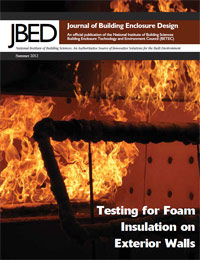Sponsorship Oportunities |
BEC Charleston: Fall Symposium with John Straube |
|||
| 'Sponsor Flyer' 'Sponsor Registration' |
John Straube, Ph.D., P.Eng., Principal, Building Science Counsulting. Inc.. Waterloo, Ontario, Cross-Appointed Faculty Member, School of Architecture and Department of Civil and Environmental Engineering, University of Waterloo, Waterloo, Ontario | |||
3 December 2015 |
Summary
Weird Walls: Better enclosure practices for less common structures.We know how to build a Perfect Wall, but for reasons of economy, historic preservation, strength, or aesthetics other solutions abound—precast, ICF, SIPS, existing masonry wall retrofits, new concrete tilt-up, impact-resistant construction, etc. How can building science improve these wall assemblies in terms of water management, thermal performance, and air tightness? How should we handle practical issues regarding code compliance, structure, detailing, and construction? Membranes: The key to effective control layers.As building practices and codes catch up with our scientific understanding of the importance of control layers in creating effective and durable enclosures, the range of building membranes in use today has become bewildering—vapor permeable, vapor impermeable, fluid applied, peel-n-stick, etc. This has complicated traditional approaches to selection, detailing, code compliance, installation, and material compatibility. Windows, Exterior Insulation & Cladding: Solving the puzzle.The Perfect Wall tells us that insulation should be placed outside the structure, but that complicates traditional methods for integrating windows, insulation, and cladding. Just what changes does exterior wall insulation entail in terms of structure, detailing, code compliance, and installation? Low-Slope, High-Performance Roofs.Once you care about energy performance everything changes—and even if you don’t care, the energy code cares, so you have to care. To improve the energy performance of our roofs, we have to reconsider our assemblies to insure durability and proper air and moisture management. Air leakage: Why should you care in a hot-humid climate?Air leakage presents special concerns for buildings in a hot-humid climate. How and why should we test air leakage of whole buildings? What problems can result air leaks and loss of pressure control? What are the implications for mold/fungal growth? Are the building code requirements adequate? Mold Is (Not) Gold: Mold proofing & other challenges.It seems that building owners, developers, design professionals, code enforcement officials, and attorneys—among others—believe a building enclosure in a hot-humid climate be designed and constructed to never have a mold/fungal growth problem. If so, what’s the ‘key?’ Are building code requirements adequate? If mold/fungal growth is outside the WRB, does that effect indoor air quality with a tight enclosure? Are there any code requirements/case studies/technical data suggesting that mold/fungal growth outside the WRB is a problem? If so, when does it become a problem? How do I know? Does this apply to traditional or encapsulated crawl spaces? Where is the most detrimental location for mold/fungal growth? Commercial and residential? Walls, roofs, floor plenums? Special junctions/transitions? Learning Objectives
Biography
Dr. Straube’s internationally recognized expertise on moisture control in enclosures began with his interest, as a graduate student, in rainscreen and brick veneer wall systems. His early career also demonstrates his adventurous attitude: traveling across North America, South America, Europe, Asia and the Caribbean, he worked on projects that ranged from investigating failed office towers to consulting on historically sensitive retrofits. This same adventurousness can be seen in his drive towards professional innovation – for example, he was a pioneer in the use of WUFI analysis in North America. Over the course of his career, Dr. Straube has also been deeply involved in the areas of building enclosure design and whole building performance, as a consultant, researcher, and educator. In addition to his work with BSCI, Dr. Straube is a cross-appointed faculty member in the School of Architecture and the Department of Civil and Environmental Engineering at the University of Waterloo. He was a Principal at Building Science Corporation from 2006 to 2013, and is the co-author, with Eric Burnett, of Building Science for Building Enclosures, one of few texts available with a specific focus on the principles of building science. Dr. Straube’s leadership as a building scientist and an educator has been recognized with multiple awards, including the Lifetime Achievement Award in Building Science Education from the National Consortium of Housing Research Centers (NCHRC). |
|||


 John Straube returns to Charleston for an all-day symposium on several advanced topics for building enclosures in our hot-humid climate. He will discuss new construction and renovation from a building science perspective based on real world examples, code considerations, theoretical underpinnings, and practical solutions. Consideration will also be given to areas of specific local concern, such as historic buildings, hurricanes, and seismic-resistant construction.
John Straube returns to Charleston for an all-day symposium on several advanced topics for building enclosures in our hot-humid climate. He will discuss new construction and renovation from a building science perspective based on real world examples, code considerations, theoretical underpinnings, and practical solutions. Consideration will also be given to areas of specific local concern, such as historic buildings, hurricanes, and seismic-resistant construction. John Straube, Ph.D., P.Eng., is a Principal at Building Science Consulting Inc., where he heads forensic investigations and leads research projects in the areas of low-energy building design, building enclosure performance, hygrothermal analysis, and field monitoring of wall assemblies. He is also a prolific writer, a noted public speaker, and a sought-after “performance coach” who helps other professionals coordinate their efforts and achieve higher levels of performance in their building projects. As one blogger wrote after attending a keynote speech: “he clearly loves what he does.”
John Straube, Ph.D., P.Eng., is a Principal at Building Science Consulting Inc., where he heads forensic investigations and leads research projects in the areas of low-energy building design, building enclosure performance, hygrothermal analysis, and field monitoring of wall assemblies. He is also a prolific writer, a noted public speaker, and a sought-after “performance coach” who helps other professionals coordinate their efforts and achieve higher levels of performance in their building projects. As one blogger wrote after attending a keynote speech: “he clearly loves what he does.”